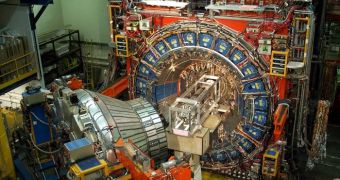The fact that the Large Hadron Collider is shut down until next year doesn't mean that discoveries in the field of quantum particle physics aren't deployed anymore. As such, researchers operating the old Tevatron device from the American Fermilab laboratory in Batavia (Illinois) stumbled upon a strange new particle last week, which they cannot explain through the means of the standard model of physics.
The Collider Detector from Fermilab (CDF) is especially designed in order to detect the outcome of the accelerated collision between protons and anti-protons taking place inside the 1.5-centimeter wide "beam pipe" of the Tevatron device. The resulting particles are monitored by means of a large amount of surrounding electronic apparatus. Last week, CDF was tracking the aftermath of a collision between bottom quarks and bottom anti-quarks that should have normally decayed into at least a pair of muons (charged particles).
The first shock came when the scientists detected a larger number of muons than previously anticipated and the second and even larger one involved the formation of muons outside of the pipe, leaving no trace in the detector's inner layer. The team is eluded by this effect and admits that it cannot be explained by regular physics, although they don't dismiss the possibility of a mundane accident having generated it. Other researchers state this means that an unknown particle with a nearly 20-picosecond lifespan was generated, traveled for about 1 centimeter through the beam pipe, and eventually decayed into muons.
According to Dan Hooper from Fermilab, "A centimeter is a long way for most kinds of particles to make it before decaying. It's too early to say much about this. That being said, if it turns out that a new 'long-lived' particle exists, it would be a very big deal". But this newly-discovered particle is very similar to a model proposed by Neal Weiner from New York University and Nima Arkani-Hamed from the Institute for Advanced Study in Princeton about the behavior of dark matter particles, although nobody cares to venture a firm opinion on this.
But even if the link is ultimately ruled out, the discovery of this kind of particle and of its strange behavior still remains an important breakthrough which may determine scientists to investigate the limits of physics, or better yet, of their knowledge of it. As always in such cases, perhaps time will tell.

 14 DAY TRIAL //
14 DAY TRIAL //